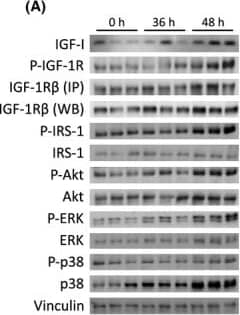Mouse IGF-I/IGF-1 Antibody
R&D Systems, part of Bio-Techne | Catalog # AF791


Key Product Details
Species Reactivity
Validated:
Cited:
Applications
Validated:
Cited:
Label
Antibody Source
Product Specifications
Immunogen
Gl33-Ala102
Accession # Q8CAR0
Specificity
Clonality
Host
Isotype
Endotoxin Level
Scientific Data Images for Mouse IGF-I/IGF-1 Antibody
Cell Proliferation Induced by IGF-I/IGF-1 and Neutralization by Mouse IGF-I/IGF-1 Antibody.
Recombinant Mouse IGF-I/IGF-1 (Catalog # 791-MG) stimulates proliferation in the MCF-7 human breast cancer cell line in a dose-dependent manner (orange line). Proliferation elicited by Recombinant Mouse IGF-I/IGF-1 (15 ng/mL) is neutralized (green line) by increasing concen-trations of Goat Anti-Mouse IGF-I/IGF-1 Antigen Affinity-purified Polyclonal Antibody (Catalog # AF791). The ND50 is typically 0.2-1.0 µg/mL.IGF-I/IGF-1 in Mouse Embryo.
IGF-I/IGF-1 was detected in immersion fixed frozen sections of mouse embryo (13 d.p.c.) using Goat Anti-Mouse IGF-I/IGF-1 Antigen Affinity-purified Polyclonal Antibody (Catalog # AF791) at 15 µg/mL overnight at 4 °C. Tissue was stained using the Anti-Goat HRP-DAB Cell & Tissue Staining Kit (brown; Catalog # CTS008) and counterstained with hematoxylin (blue). Lower panel shows a lack of labeling when primary antibodies are omitted and tissue is stained only with secondary antibody followed by incubation with detection reagents. Specific staining was localized to developing brain and muscle cells. View our protocol for Chromogenic IHC Staining of Frozen Tissue Sections.Detection of Mouse IGF-I/IGF-1 by Western Blot
Activation of IGF signaling pathways 36 and 48 h after i.p. injection of paraquat. (A) WB detection of IGF-I from blood and of key signal transduction proteins in IGF pathways (P-tyrosine-activated forms and total protein) from lung tissue. Gel loading was controlled by vinculin. (B) Quantification of WB by chemiluminescence. Phosphotyrosine-IGF-1R (P-IGF-1R) and P-IRS-1 were detected using a phosphotyrosine-specific antibody after IP. Note that increase in IGF-1R abundance over time was very similar whether detected from IP samples or by direct WB. Tests were performed in 11- to 13-week-old mice. N = 3 per group; mean ± SEM, expressed in arbitrary units. *P < 0.05, Mann–Whitney U-test. Image collected and cropped by CiteAb from the following open publication (https://pubmed.ncbi.nlm.nih.gov/23898955), licensed under a CC-BY license. Not internally tested by R&D Systems.Applications for Mouse IGF-I/IGF-1 Antibody
Immunohistochemistry
Sample: Immersion fixed frozen sections of mouse embryo (E13)
Western Blot
Sample: Recombinant Mouse IGF-I/IGF-1 (Catalog # 791-MG)
Neutralization
Reviewed Applications
Read 2 reviews rated 4 using AF791 in the following applications:
Formulation, Preparation, and Storage
Purification
Reconstitution
Formulation
Shipping
Stability & Storage
- 12 months from date of receipt, -20 to -70 °C as supplied.
- 1 month, 2 to 8 °C under sterile conditions after reconstitution.
- 6 months, -20 to -70 °C under sterile conditions after reconstitution.
Background: IGF-I/IGF-1
Insulin-like growth factor I, also known as somatomedin C, is the dominant effector of growth hormone and is structurally homologous to proinsulin. Mouse IGF-I is synthesized as two precursor isoforms with alternate N- and C-terminal propeptides (1). These isoforms are differentially expressed by various tissues (1). The 7.6 kDa mature IGF-I is identical between isoforms and is generated by proteolytic removal of the N- and C-terminal regions. Mature mouse IGF-I shares 94% and 99% aa sequence identity with human and rat IGF-I, respectively (2), and exhibits cross-species activity. It shares 60% aa sequence identity with mature mouse IGF‑II. Circulating IGF-I is produced by hepatocytes, while local IGF-I is produced by many other tissues in which it has paracrine effects (1). IGF-I induces the proliferation, migration, and differentiation of a wide variety of cell types during development and postnatally (3). IGF-I regulates glucose and fatty acid metabolism, steroid hormone activity, and cartilage and bone metabolism (4-7). It plays an important role in muscle regeneration and tumor progression (1, 8). IGF-I binds IGF-I R, IGF-II R, and the insulin receptor, although its effects are mediated primarily by IGF-I R (9). IGF-I association with IGF binding proteins increases its plasma half-life and modulates its interactions with receptors (10).
References
- Philippou, A. et al. (2007) In Vivo 21:45.
- Bell, G.I. et al. (1986) Nucleic Acids Res. 14:7873.
- Guvakova, M.A. (2007) Int. J. Biochem. Cell Biol. 39:890.
- Clemmons, D.R. (2006) Curr. Opin. Pharmacol. 6:620.
- Bluher, S. et al. (2005) Best Pract. Res. Clin. Endocrinol. Metab. 19:577.
- Garcia-Segura, L.M. et al. (2006) Neuroendocrinology 84:275.
- Malemud, C.J. (2007) Clin. Chim. Acta 375:10.
- Samani, A.A. et al. (2007) Endocrine Rev. 28:20.
- LeRoith, D. and S. Yakar (2007) Nat. Clin. Pract. Endocrinol. Metab. 3:302.
- Denley, A. et al. (2005) Cytokine Growth Factor Rev. 16:421.
Long Name
Alternate Names
Gene Symbol
UniProt
Additional IGF-I/IGF-1 Products
Product Documents for Mouse IGF-I/IGF-1 Antibody
Product Specific Notices for Mouse IGF-I/IGF-1 Antibody
For research use only

